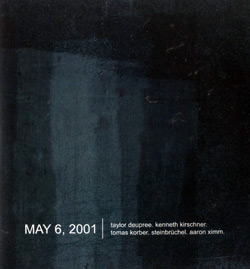
From the Pacific Northwest's most visible city, Seattle's and/OAR label has been quietly — surely and steadily — passing considerable muster amongst experimental music's cognoscenti. Aligned with a veritable who's who of folks doing work around, throughout and across the margins, artists bursting at the underground's seams where the truly innovative recordings reside, label owner Dale Lloyd's a crafty conduit for talent; each and/OAR release, smartly if simply packaged (though Lloyd's recently moved the catalog into more tangible digipaks), offers tantalizing glimpses into psyches pushing at those sacred envelopes, be it isolationist drone, murky microsound, electroacoustic paraphrasing or any number of twilight zones in between.
The best and the brightest are well represented on May 6, 2001. The nucleus of the recording arises from, as the inside sleeve tells it, "a field recording by Kenneth Kirschner recorded in the financial district of Lower Manhattan on May 6, 2001." Exactly how that date is significant is unclear, nor is the modus operandi of said "field recording" in evidence anywhere amongst the five contributors tracks. Nevertheless, what is significant is that each artist, in their own indomitable styles, has flensed out whatever inherent traits Kirschner's sample contained. Distorted low-end "bass" thrums launch Steinbruchel's "Bank" until long-distance cushioned static charges and a single elongated tone attacks the fundamental waveform: one could almost see this as the artist's "re-imagining" of Alvin Lucier's "Music On A Long Thin Wire" outputted through the skein of contemporary signal processors. Brittle, if a bit cold, it remains well connected to Steinbruchel's trademark imprimatur. Aaron Ximm's built a respectable career out of documenting sonic texture via his own astute field recordings, but "Negative Architectures" is nothing if not atypical: fixing Kirschner's sample inside a cyclotron, he's concocted a diminuitive tornadic whirligig of sound that tosses off random bits like so much aural debris.
Kirschner's own contribution makes a blizzard out of Steinbruchel's narrow tone, stretching it tautly across barren, desolate horizons creased by digitalia as tiny microevents attempt to rise above the machinic gusts — riveting stuff for certain. Tomas Korber chimes in with the lengthiest piece: at over 22 minutes, "Financial District" at first is barely noticeable, just near-invisible curdling sounds that gently fizz right at audibility's edge, but it doesn't last long. Soon those brusque digital windstorms blow again, gusty enough to achieve torrential rage, the rising rocket exhaust blast attaining Merzbow-ian proportions, before those earlier sound curdles begin to metamorphose into herds of otherworldly, scuttling microorganisms — listen close and revel. Finally, Taylor Deupree's closing "Dust" is the "sunniest" piece of all, its somersaulting hums and strange rubbings something of a balm compared to the coarser grains that preceded it. Rubberstamp the date: May 6, 2001 affixes itself in memory sans any pre-existing genre conditions.
Comments and Feedback:
|



